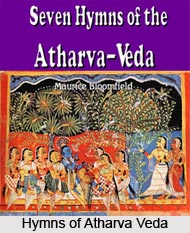 Hymns in Book VII of Atharva Veda commences with power of prayer. It also has a prayer to Lord Agni. Next two hymns are praises of Atharvan as well as Agni. The fourth hymn is dedicated to Vayu. The fifth hymn is veneration of sacrifice. The succeeding hymn is a prayer to Aditi seeking help and protection. Praise of the Adityas form the seventh hymn. The eighth hymn is wishing a successful journey to a departing traveller.
Hymns in Book VII of Atharva Veda commences with power of prayer. It also has a prayer to Lord Agni. Next two hymns are praises of Atharvan as well as Agni. The fourth hymn is dedicated to Vayu. The fifth hymn is veneration of sacrifice. The succeeding hymn is a prayer to Aditi seeking help and protection. Praise of the Adityas form the seventh hymn. The eighth hymn is wishing a successful journey to a departing traveller.
The next four hymns are prayers: to Pushan seeking protection and restoration of lost property, favour of Saraswati, protection of corn from lightning and drought, for influence at religious meetings. The thirteenth hymn is a charm in order to win superiority over enemies. The following hymn is a prayer to Savitr for success.
A charm in order to win heavenly favour forms the fifteenth hymn. The following five hymns are prayers for: prosperity, wealth and children, rain and happiness. Twenty first
Hymn is a funeral. The next hymn is dedicated to Savitr. A charm in order to deport fiends as well as troubles forms the twenty third hymn. The next one is a prayer for riches. The following two hymns are praises of Vishnu and Varuna. The twenty seventh hymn is a prayer to Ida who is considered as Goddess of devotion. The twenty eighth hymn is a praise of the sacrificial utensils. The next hymn is dedicated to Lord Agni and Lord Vishnu. A charm that needs to be used when the eyes are smeared forms the thirtieth hymn. The succeeding five hymns are prayers: the defeat of enemies, to Agni for long life, children and prosperity, for freedom from sin, King and his kingdom`s prosperity. The thirty sixth hymn is a charm that needs to be pronounced by bride and bridegroom.
The following one is a nuptial charm that needs to be uttered by the bride. A maiden`s love fascination forms the thirty eighth hymn. The following hymn is a sacrificial charm for rain and prosperity. The next three hymns are prayers for prosperity as well as for liberation from sin and sickness. The forty third hymn is a charm against lightning.
The next hymn is dedicated to Lord Indra and Vishnu. The next two hymns are charms against jealousy as well as for prosperity. The next three hymns are prayers for wealth and birth of a son, for prosperity and for children and treasure. The fiftieth hymn is a gambler`s prayer for triumph in gaming. The next two hymns are prayers for protection of Indra and Brishaspati as well as for harmony. The subsequent five hymns are charms: to recover a sick man at a time when he is dying, to obtain Vedic knowledge, ensuring successful journey, against poisonous bites and for some physical disorder. Fifty eighth hymn is an invitation to Lord Indra and Varuna. The next one is an imprecation. The sixty first hymn is a parting traveller`s address to the houses of his village. The next three hymns are prayers for: sacred knowledge, overthrow of enemies and liberation from affliction. The subsequent two hymns are charms to avert an evil omen as well as against imprecation. The sixty sixth hymn is a prayer to speech. The next three hymns are prayers: prayer of a priest to the Agnayo Dhishnyah, for children and prosperity.
The seventieth hymn is a charm to disturb an enemy`s sacrifice. The succeeding one praises Agni. Thereafter two hymns are invitations to Indra and Asvins. The seventy fourth one is a charm to cure boils. Benediction on cows forms the seventy fifth hymn.
The following hymn is a charm to cure boils. A chant against an enemy is seventy seventh hymn. A charm seeking prosperity of the prince forms the next hymn. The next three hymns are dedicated to new and full moon. Praise of Agni is the next hymn. Liberation from sin forms the eighty third hymn. The hymn thereafter is a prayer for safety. Next two hymns are charms to ensure victory in war. The eighty seventh hymn is a prayer to Rudra. The succeeding one is a magic to cure snake-bite. A plea for prosperity and purification forms the eighty ninth hymn. Thereafter is a charm against a rival in love. The next three hymns are prayers for protection and success in battle. A charm to guarantee the obedience of subjects forms the ninety fourth hymn. Subsequent two hymns are incantations against an undetected thief. Sacrificial methods form the next hymn. Smearing grass from the ninety eighth hymn. The ninety ninth hymn is the obtain pardon for an rude act.
The hundred and third one is the cry of a priest who is unemployed. A prayer for prosperity is the next hymn. Hundred and fifth is an initiation formula. The following hymn is a prayer for forgiveness of sin. A charm against cough forms the hundred and seventh hymn. The consequent five hymns are prayers for protection, success in gambling, success in battle, for offspring and freedom from sin. The next two hymns are a woman`s incantation against a rival. The next three hymns are charms against misfortune, fever and for ensuring prosperity. The hundred and eighteen hymn is a blessing on a warrior.



















